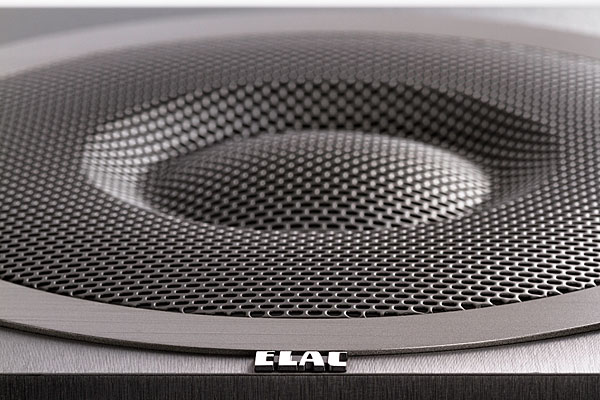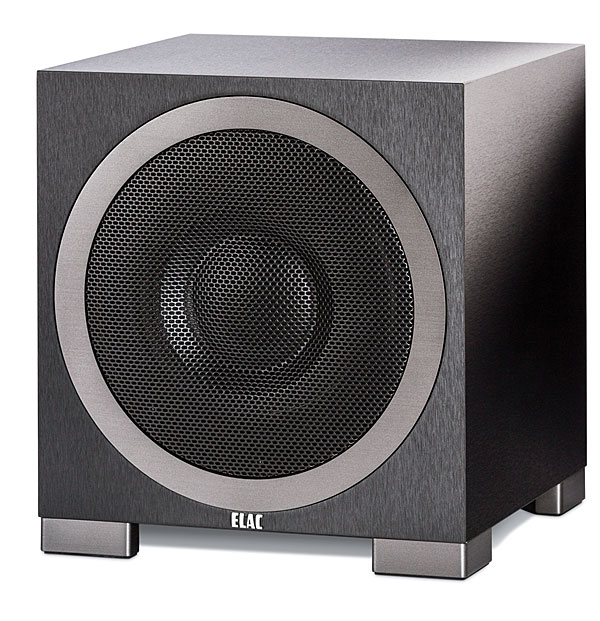Elac Debut F5 Speaker System Review

AT A GLANCE
Plus
Superb sonics, neutral tonal balance
Decently finished, simple look
Unapproachable value
Minus
Some off-axis center-channel tonal shift
Audible thump on sub’s auto turn-off
THE VERDICT
Elac’s Debut series reintroduces a near-forgotten brand with a design by a well-known name—Andrew Jones—and a value/performance factor to be reckoned with.
As longtime S&V readers have doubtless come to understand, I believe that cheap, as Gordon Gekko definitely did not say, is good. Any $10,000 pair of loudspeakers makes me vaguely uneasy, while a $50,000 pair leaves me ready to join the Che Guevara Brigade and start lining up oligarchs. So the arrival of a new family of cheap—err, high-value—serious loudspeakers from Elac U.S., designed by tech’lebrity engineer Andrew Jones, caused a certain amount of excitement hereabouts. (For more on Elac and Jones, see “Man on a Mission”.)
Briefly, then: Elac is a 90-year-old German radio/audio/appliance manufacturer with roots in sonar and early radar—about which, given the historical period, the less said probably the better. The company was last seen on these shores nearly a half-century ago as purveyor of the long-extinct Elac/Miracord turntables and record changers (little mourned by audiophiles, it must be said). Elac’s re-entry into the U.S. market rides the rails of the new, value-priced loudspeaker lineup under our gaze here, the Debut series of conventional cone-and-dome models, all designed by the estimable Mr. Jones. Jones did similar service for Pioneer a few years back, and on casual visual inspection, the two lines have some things in common: fundamental design parameters, basic shapes and sizes, and a certain parallelism in pricing. Whatever is behind this, I honestly can’t say: I’ve never met Jones, and I have no inside industry gossip, at least in this case.
Anyway, my job is to judge the speakers, not the industrial melodrama (if any) behind them. Elac U.S. sent us pairs of the Debut lineup’s flagship F5 tower and the smaller of two bookshelf models, the B5, for surround duties. Rounding out the system are the C5 center-channel speaker and the middle of three subwoofer options, the 10-inch S10EQ. A speaker-topper for Dolby Atmos, the A4 ($230/pair), was alas not available in time for this look.
The Setup
Setting up the Debuts was undemanding, not least because
the tower and the sub are each comfortably below the 50-pound mark that disqualifies me for work as a UPS driver. The F5 tower looks rather pedestrian with its ordinary knit-black grille in place, but with it removed (as I did for listening to the full system), the dully gleaming weave of the driver’s aramid-fiber cones lent a decidedly high-tech allure. Otherwise, the Elacs are all plain black-vinyl boxes, but clearly well made (in China) with heavier drivers, higher-grade crossover components, double-ducted ports, and solid metal binding posts (singles), all rather better than I’d expect in this price bracket. (Closer inspection was foiled by the plastic trim rings around the drivers, which proved stubbornly resistant to removal.)
Interestingly, the F5s proved a bit more forgiving to proximity to the front wall than many similarly configured speakers I’ve auditioned. They produced reasonably even in-room bottom octaves as close as 2 feet forward—and in my usual positions, approximately 4 feet into the room, they were just about optimal. The C5 center went on my usual low stand just below my video monitor, while I placed the B5s as always on high shelves straddling the listening position, angled rearward to wash some diffused sound along the walls.

The most interesting setup story here is that of the S10EQ sub- woofer, which I located in my long- established, acoustically optimum spot to the right of the RF tower. Even with just a casual level match via my pre/pro’s calibration noise tone, this made a very respectable blend with the towers, but further tuning—a great deal more than from any other $500 sub I know of—is available. Available, that is, if you’re tech-savvy enough to have an iOS or Android device on the premises, since Elac offers a free app for each to access the sub’s controls and auto EQ abilities. And you’d better be so equipped, because the S10EQ has no physical controls whatsoever on its rear panel, just a power-cord socket and a reset button. (Elac also offers a 10-inch, simple-ported S10 sub, lower-powered and EQ-less for precisely half the money. But in my view, the S10EQ is more than worth the added cost; there’s also a 12-inch, higher-powered S12EQ for $700.) The app’s auto EQ feature includes a step to calibrate to the iOS/Android device’s actual microphone response. This displays both the measured low-frequency room response and the correction curve that the sub applies, and it appeared to work as advertised, showing a curve consistent with what I’ve seen from other room-correction systems. (Of course, if your A/V receiver or pre/pro already incorporates Audyssey or a similarly competent room-correction system, this feature may be superfluous; on the other hand, it gives another option for comparison.)
The Sounds
This is one case where I’m not going to bury the lede: These are extra-
ordinarily good loudspeakers. Extraordinarily good even at twice the price, and still highly competitive at three times. If my long-term monitors were still made today, they’d likely sell for about 10 times the F5 towers’ cost, but the Elacs matched them extremely closely, not only in tonal balance and range but also in clarity and dimensionality. As heard with an old favorite reference CD like Phil Woods’ Here’s to My Lady (Chesky), my own speakers showed a very slight advantage in upper-octaves airiness on things like ride-cymbal sheen and snare-attack leading edge; otherwise, there was basically zero advantage either way. The F5s went plenty low on their own, subwoofer-less, for satisfying listening on most music, including full orchestra; in my room, at a guess, their useful limit was around 40 hertz. But with the sub dialed in via Elac’s app on my iPad mini, nearly the full deeper octave appeared on tap, with virtually undetectable change in bass character or smoothness, suggesting that the app does its job quite effectively (and that the sub was engineered with blending as well as raw output in mind).

The C5 center-channel speaker made a very close tonal match to the towers, differing only in what I heard as noticeably less heft in the male-voice octaves, though most female announcers were virtually indistinguishable when switching between mono (the C5) and stereo (the F5 pair). And even this difference could be mitigated, somewhat, by fiddling with center-channel crossover frequency and sub level, though this tended to result in an overall sub volume too high for my taste. Also, like nearly all other horizontal, dual-woofer, two-way centers, the C5 displayed a fairly marked change in tonality when auditioned well off axis—say, 30 degrees or more—becoming by comparison a tad “cupped” or hollow sounding. But this shouldn’t prove a problem in typical three-across seating, unless the sofa is very close to the screen.
All told, the Elac suite produced terrifically impressive multichannel sound. Tom Petty and the Heartbreakers’ Mojo on Blu-ray Audio, a fine surround mix if not a great album, was beautifully smooth yet crisp. The DTS-HD Master Audio track delivered an excitingly in-room impact from snare hits and power-chord stabs that most speakers in this price range simply fail to muster.
Translating this goodness to film sound was no problem for the Elacs. A recent Blu-ray arrival, the Brad Peyton–directed thrill ride San Andreas, produced all the mayhem and madness any home theater buff could desire. The Debut suite created a solidly integrated front stage, so that elements like laterally flying helicopters and racing Town Cars held together seamlessly, with smooth pans and a convincing sense of depth, while the SE10EQ did yeoman’s work with the deep bass (and even infra-bass) of the temblors. And that’s just chapter 4.
The B5 bookshelf-sized two-ways worked competently in the surround positions, adding a decent bubble of surround ambience—not as enveloping as what I hear from my everyday dipole surrounds, but quite acceptable, as I find to be the case from most smaller two-ways. (Dipoles seem to have fallen out of favor, generally, in surround speaker families. Why?) These smaller of the two bookshelf Debut models, by the way, made a fairly close match to the F5 towers in direct comparisons, but the three-way towers displayed a definite advantage in midrange transparency and image depth.


Any film with an earthquake and a Rock (Dwayne Johnson) as its marquee attractions is certain to serve up some suitable subwoofer stressors, and San Andreas did not disappoint. (If you collect Blu-rays to show off your system, add this one to your list.) Nor did Elac’s compact but effective S10EQ. With plenty of bottom-octave impact and a welcome dearth of second- to third-octave boom, the surprisingly small sub left very little to be desired up to about 6 decibels shy of “reference” level in my studio—which, conveniently, is about the upper reach of my for-pleasure listening demands. Pushing further caused the Elac to go a tiny bit flabby and “clacky,” and the last half-octave of (ahem!) seismic infra-bass was lacking in authority, but hey—this is a $500 sub. With auto EQ! (And a couple of bills more would buy the larger and likely louder S12EQ.)
So the Winner Is…
You. Me. Us. The bottom line is obvious: Elac’s Debut—uh, debut—is a flag-waving success. One could draw numerous conclusions here; mine is that dogged conventional-driver engineering, careful tonal balancing, and an expert designer’s ear still trump exotic materials and “all-new” driver technologies, at least where cost/performance is king. Any speaker shoppers as careful of their dimes as their dollars—and not insistent upon rounded corners, real-wood veneers, or high-tech innovations—must audition the Elac Debut speakers. Their performance is impressive even without reference to price, while their value rating is off the charts, and even right off the paper. Highly recommended.
- Log in or register to post comments






























































